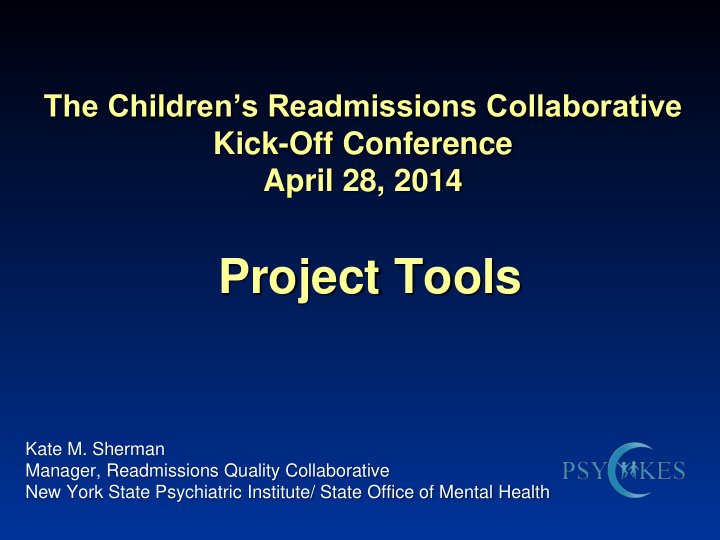



The Children’s Readmissions Collaborative Kick-Off Conference April 28, 2014 Project Tools Kate M. Sherman Manager, Readmissions Quality Collaborative New York State Psychiatric Institute/ State Office of Mental Health
Project Tools Types of Project Tools Clinical Tools After Hospital Care Plan (required project intervention) Others as needed Project Management Tools, e.g.: Action Plan Root Cause Analysis (in development) Tools that support both, e.g.: Psychiatric Services and Clinical Knowledge Enhancement System (PSYCKES) Benefit of participation in the Collaborative Sharing tools Developing common tools
Developing and Teaching the After Hospital Care Plan
Project RED (Re-Engineered Discharge) Background Developed at Boston University, 2003 to present Recognized/utilized by numerous quality improvement (QI) organizations Agency for Healthcare Research and Quality (AHRQ) Institute for Healthcare Improvement (IHI) Evidence-based practice in Medical/Surgical settings; highly applicable to Psychiatry 12 Mutually reinforcing practices – Keys: After Hospital Care Plan (AHCP) Patient/caregiver education (teach-back) Follow-up phone call
AHCP Cover Page Includes contact information
AHCP Medication Page
AHCP Appointment Page
AHCP Appointment Calendar
AHCP Patient Activation Page
AHCP Primary Diagnosis Page Includes self-care, allergies, pharmacy number
AHCP Key Principles: Developing/Documenting the Plan **Simple language** No medical terms / jargon / abbreviations **Provides contact information** “Just right” amount of information Visual aids Includes purpose of medications, appointments Gives both brand and generic names How does your current format compare?
AHCP Key Principles: Teaching the Plan **Identify the learner** ** Use “teach - back” method ** More than reading the plan to client/family Ask them to say it back (e.g., “I want to make sure I explained that clearly,” or “how will you explain this to your husband when you get home?”) Assess understanding Teach throughout the inpatient stay (and after)
PSYCKES: Readmissions Indicators
PSYCKES Background PSYCKES is a web-based platform for sharing Medicaid claims data Behavioral health population, 4.6 million individuals Resources Training webinars offered regularly Public website: www.psyckes.org Print materials and recorded webinars available PSYCKES Help
Uses of PSYCKES to Support Readmissions Project Clinical Summary: use in all settings to identify those at risk of readmission; see flags: Readmission High utilization Med adherence Readmissions Indicators Inpatient: Track performance on readmissions after discharges from your hospital Outpatient: Track overall readmission rate for clients served in your program; generate high-risk list
PSYCKES QI Overview Click on summary indicator to see indicators in the set
Readmission Indicators in PSYCKES “Readmissions – Hospital- Specific” Indicator: Individuals whose discharges from your hospital’s behavioral health inpatient were followed by readmission to the same service type at any institution Within 15, 30 or 45 days “Readmissions – All Behavioral Health” Indicator: Individuals served at your program who were discharged from behavioral health inpatient at any institution and readmitted to any institution Within 7, 30 or 45 days
QI Indicators within the Set All behavioral health versus hospital-specific; various time frames
Modify Filters Click “Modify Filter” to define universe of clients Filter by age range
Data filtered by age 0-17
Clinical Summary Header Includes: client demographics, quality flags, diagnoses, graph
PSYCKES 30-day Readmissions Data Participating Hospitals, Ages 0-17 # Discharged # Readmitted Prevalence Regional Statewide Hospital Number (Denominator) (Numerator) % % % 1* 80 2 2.5 9.1 11.72 2* 143 11 7.7 9.1 11.72 3 209 18 8.6 11.4 11.72 4 317 29 9.1 12.9 11.72 5* 151 15 9.9 9.1 11.72 6* 173 18 10.4 9.1 11.72 7 158 17 10.8 11.4 11.72 8 165 19 11.5 11.4 11.72 9 226 28 12.4 11.4 11.72 10 908 125 13.8 12.9 11.72 11 259 42 16.2 11.4 11.72 12 35 6 17.1 14.0 11.72 13 296 53 17.9 14.0 11.72 14 75 14 18.7 11.4 11.72 * State-Operated Psychiatric Center
The Action Plan
The Action Plan: Purpose and Structure Road map for the project Plan project activities Start-up tasks Delivery of project interventions Tracking Anticipate and plan to address barriers Aligns with List of project interventions Project reporting
The Action Plan What? How? Who? When?
The Action Plan
The Action Plan: Today’s Assignment Complete first page: leave here with a “to do” list for implementing the project Start thinking about / completing the other pages Phase in interventions over time Each setting starts with one item Complete last page: anticipated barriers and how to address them. Report out to the group on your plan at the end
Question and Answer
Recommend
More recommend